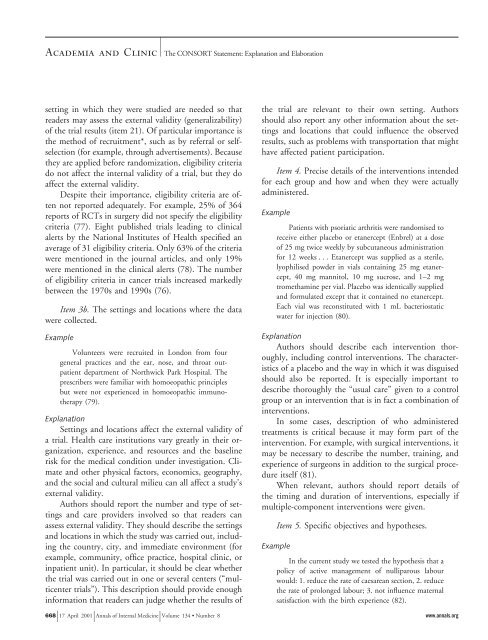The Revised CONSORT Statement for Reporting Randomized Trials
The Revised CONSORT Statement for Reporting Randomized Trials
The Revised CONSORT Statement for Reporting Randomized Trials
You also want an ePaper? Increase the reach of your titles
YUMPU automatically turns print PDFs into web optimized ePapers that Google loves.
Academia and Clinic <strong>The</strong> <strong>CONSORT</strong> <strong>Statement</strong>: Explanation and Elaboration<br />
setting in which they were studied are needed so that<br />
readers may assess the external validity (generalizability)<br />
of the trial results (item 21). Of particular importance is<br />
the method of recruitment*, such as by referral or selfselection<br />
(<strong>for</strong> example, through advertisements). Because<br />
they are applied be<strong>for</strong>e randomization, eligibility criteria<br />
do not affect the internal validity of a trial, but they do<br />
affect the external validity.<br />
Despite their importance, eligibility criteria are often<br />
not reported adequately. For example, 25% of 364<br />
reports of RCTs in surgery did not specify the eligibility<br />
criteria (77). Eight published trials leading to clinical<br />
alerts by the National Institutes of Health specified an<br />
average of 31 eligibility criteria. Only 63% of the criteria<br />
were mentioned in the journal articles, and only 19%<br />
were mentioned in the clinical alerts (78). <strong>The</strong> number<br />
of eligibility criteria in cancer trials increased markedly<br />
between the 1970s and 1990s (76).<br />
Item 3b. <strong>The</strong> settings and locations where the data<br />
were collected.<br />
Example<br />
Volunteers were recruited in London from four<br />
general practices and the ear, nose, and throat outpatient<br />
department of Northwick Park Hospital. <strong>The</strong><br />
prescribers were familiar with homoeopathic principles<br />
but were not experienced in homoeopathic immunotherapy<br />
(79).<br />
Explanation<br />
Settings and locations affect the external validity of<br />
a trial. Health care institutions vary greatly in their organization,<br />
experience, and resources and the baseline<br />
risk <strong>for</strong> the medical condition under investigation. Climate<br />
and other physical factors, economics, geography,<br />
and the social and cultural milieu can all affect a study’s<br />
external validity.<br />
Authors should report the number and type of settings<br />
and care providers involved so that readers can<br />
assess external validity. <strong>The</strong>y should describe the settings<br />
and locations in which the study was carried out, including<br />
the country, city, and immediate environment (<strong>for</strong><br />
example, community, office practice, hospital clinic, or<br />
inpatient unit). In particular, it should be clear whether<br />
the trial was carried out in one or several centers (“multicenter<br />
trials”). This description should provide enough<br />
in<strong>for</strong>mation that readers can judge whether the results of<br />
the trial are relevant to their own setting. Authors<br />
should also report any other in<strong>for</strong>mation about the settings<br />
and locations that could influence the observed<br />
results, such as problems with transportation that might<br />
have affected patient participation.<br />
Item 4. Precise details of the interventions intended<br />
<strong>for</strong> each group and how and when they were actually<br />
administered.<br />
Example<br />
Patients with psoriatic arthritis were randomised to<br />
receive either placebo or etanercept (Enbrel) at a dose<br />
of 25 mg twice weekly by subcutaneous administration<br />
<strong>for</strong> 12 weeks ... Etanercept was supplied as a sterile,<br />
lyophilised powder in vials containing 25 mg etanercept,<br />
40 mg mannitol, 10 mg sucrose, and 1–2 mg<br />
tromethamine per vial. Placebo was identically supplied<br />
and <strong>for</strong>mulated except that it contained no etanercept.<br />
Each vial was reconstituted with 1 mL bacteriostatic<br />
water <strong>for</strong> injection (80).<br />
Explanation<br />
Authors should describe each intervention thoroughly,<br />
including control interventions. <strong>The</strong> characteristics<br />
of a placebo and the way in which it was disguised<br />
should also be reported. It is especially important to<br />
describe thoroughly the “usual care” given to a control<br />
group or an intervention that is in fact a combination of<br />
interventions.<br />
In some cases, description of who administered<br />
treatments is critical because it may <strong>for</strong>m part of the<br />
intervention. For example, with surgical interventions, it<br />
may be necessary to describe the number, training, and<br />
experience of surgeons in addition to the surgical procedure<br />
itself (81).<br />
When relevant, authors should report details of<br />
the timing and duration of interventions, especially if<br />
multiple-component interventions were given.<br />
Example<br />
Item 5. Specific objectives and hypotheses.<br />
In the current study we tested the hypothesis that a<br />
policy of active management of nulliparous labour<br />
would: 1. reduce the rate of caesarean section, 2. reduce<br />
the rate of prolonged labour; 3. not influence maternal<br />
satisfaction with the birth experience (82).<br />
668 17 April 2001 Annals of Internal Medicine Volume 134 • Number 8 www.annals.org
















